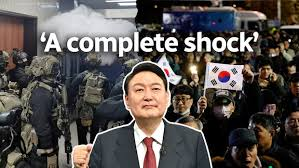Myanmar Spring Chronicle – December 4 Perspectives
(MoeMaKa, December 4, 2024)
How Do the Situations in South Korea and Myanmar Differ?
On the night of December 3, South Korean President Yoon Suk-yeol attempted to impose emergency military governance, issuing a declaration that was widely criticized as a temporary and drastic measure. This act drew comparisons with Myanmar’s military coup on February 1, 2021, as commentators analyzed the contrasting circumstances and implications of the two events.
President Yoon made his televised announcement abruptly, citing a national emergency. His declaration was immediately challenged by South Korea’s National Assembly, where opposition parties hold a majority. Within hours, the assembly convened and nullified the president’s emergency decree. Following this, President Yoon rescinded his declaration in less than 24 hours.
Unlike Myanmar, where the military seized power and installed itself as the ruling authority, South Korea’s military only complied with the president’s orders temporarily and did not initiate a power grab. Observers noted that South Korea’s military governance declaration lacked the permanence and intent to control politics that characterized Myanmar’s coup.
South Korea’s emergency governance differed from military takeovers in African countries where coups are often led by generals to secure political power. It also stands apart from Myanmar’s military regime, where the armed forces maintained decades-long control, intermittently sharing power, only to reclaim full authority later.
Fundamental Differences Between South Korea and Myanmar
While both countries experienced declarations of military involvement, South Korea’s recent event and Myanmar’s 2021 coup differ fundamentally. South Korea’s military governance declaration was not accompanied by a military takeover. This key distinction has been a focal point in discussions among Myanmar’s political circles, media, and civil society.
Many critiques highlight that South Korea’s military did not fully endorse the president’s declaration and showed respect for public sentiment and parliamentary decisions, which contrasts sharply with Myanmar’s military actions.
South Korea’s history of military rule, which followed the Korean War and extended through much of the 20th century, differs in intent and outcome. While South Korean military leaders imposed authoritarian rule, they also promoted capitalist economic systems and maintained connections with Western nations. This stands in contrast to Myanmar’s prolonged isolation and suppression under military rule.
South Korea also had strong labor unions and civil organizations that challenged military dominance, laying the groundwork for democratization. These societal dynamics are largely absent in Myanmar, where labor and agricultural unions lack the organizational strength to counter military power.
The Role of Legislative Institutions
In South Korea, the National Assembly’s ability to swiftly respond to President Yoon’s declaration was instrumental in preventing the situation from escalating. Some commentators suggest that if Myanmar’s parliament had been able to act decisively after the military’s 2021 coup declaration, the outcome might have been different.
Myanmar’s parliamentarians, however, lacked the experience and capacity to challenge the military effectively. Many were detained or restricted immediately after the coup, preventing them from convening or resisting.
Key Takeaways
The contrasting events underscore the profound differences in the political and social landscapes of South Korea and Myanmar. Factors such as South Korea’s robust economy, lack of federal issues, strong labor organizations, and well-established civil rights frameworks have helped safeguard democratic principles. These factors are largely absent in Myanmar, where the military has entrenched itself as a dominant force.
Myanmar’s armed forces seized power decisively, whereas South Korea’s military only acted on presidential orders without initiating a takeover. The underlying motivations of the two events—Myanmar’s military aiming for long-term control and South Korea’s president attempting a short-term maneuver—highlight the divergent paths taken by the two countries.
South Korea’s incident was a temporary crisis sparked by political tensions and accusations of opposition alignment with North Korea, while Myanmar’s coup was a calculated move by the military to maintain its dominance. Recognizing these differences is essential for understanding the unique challenges faced by each nation.

